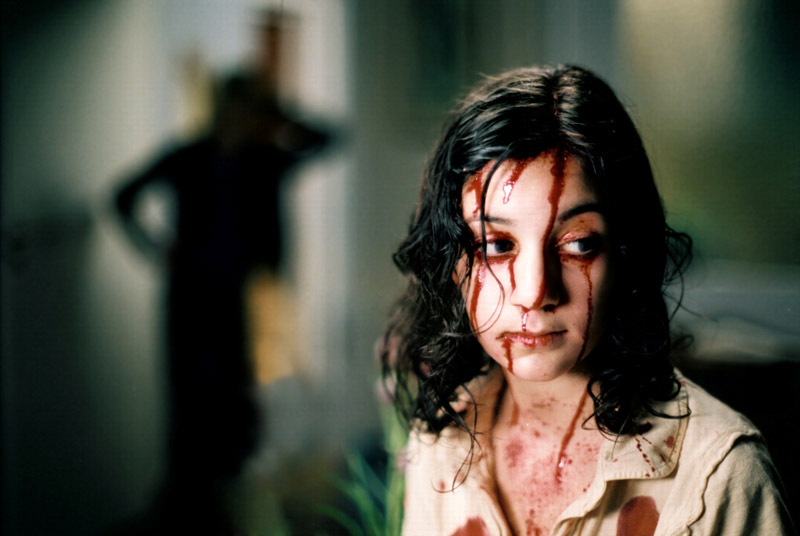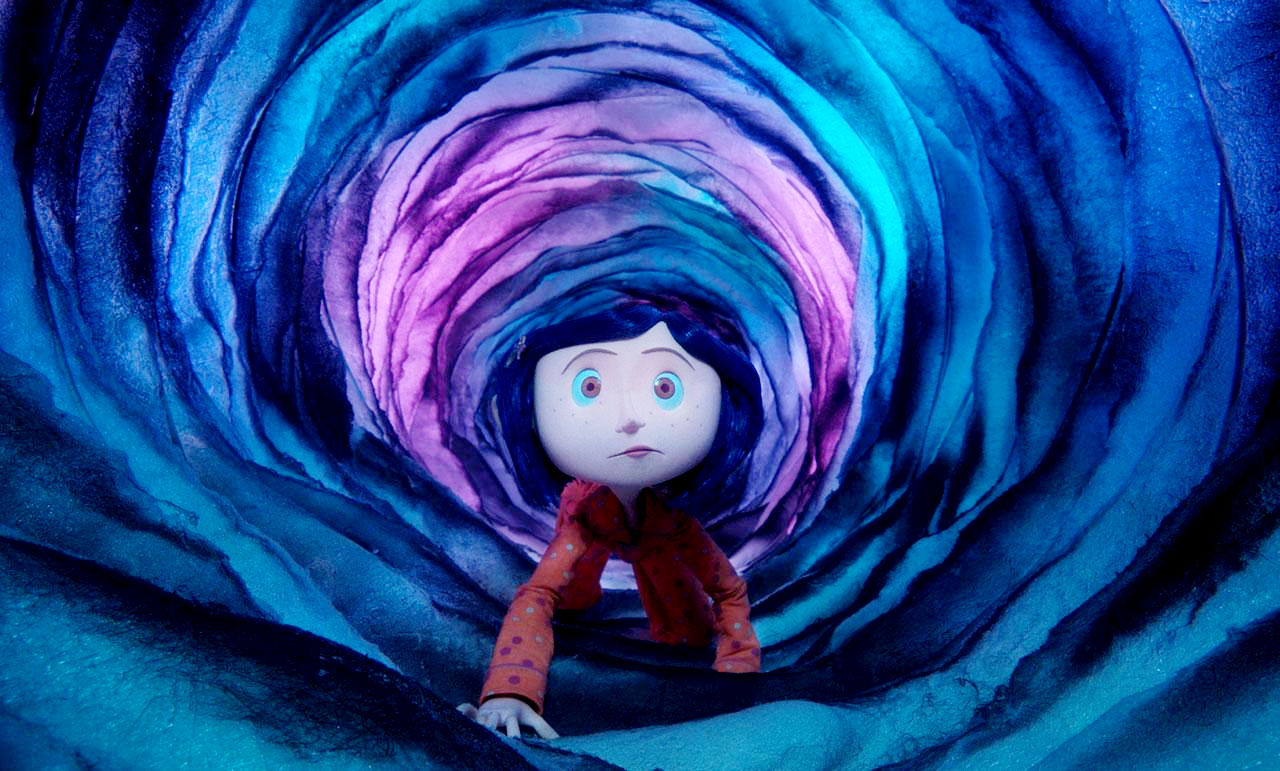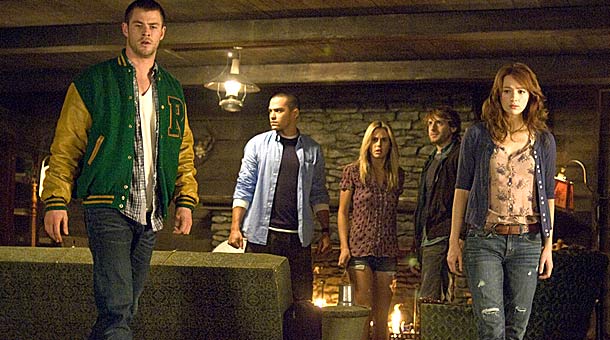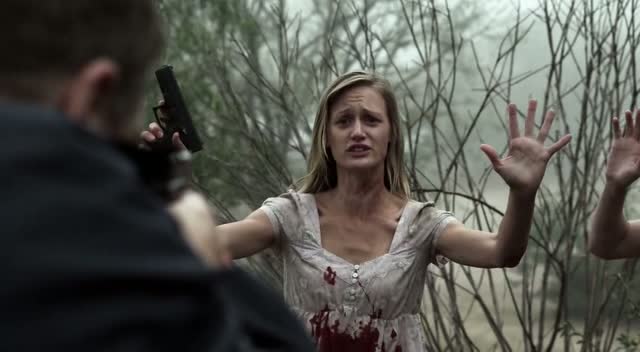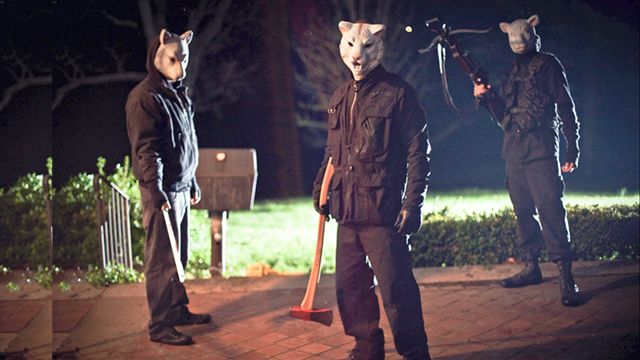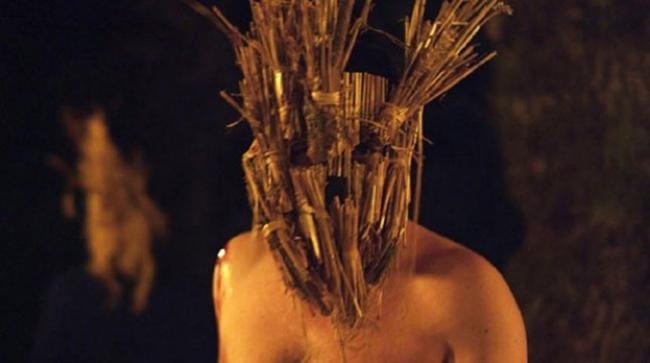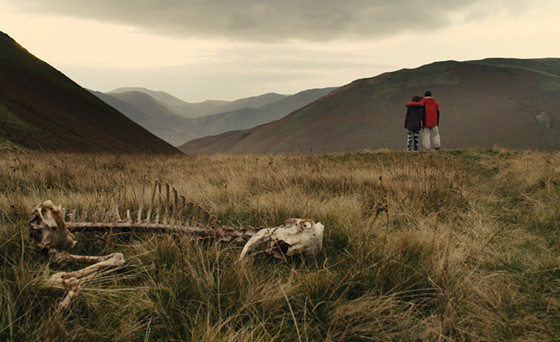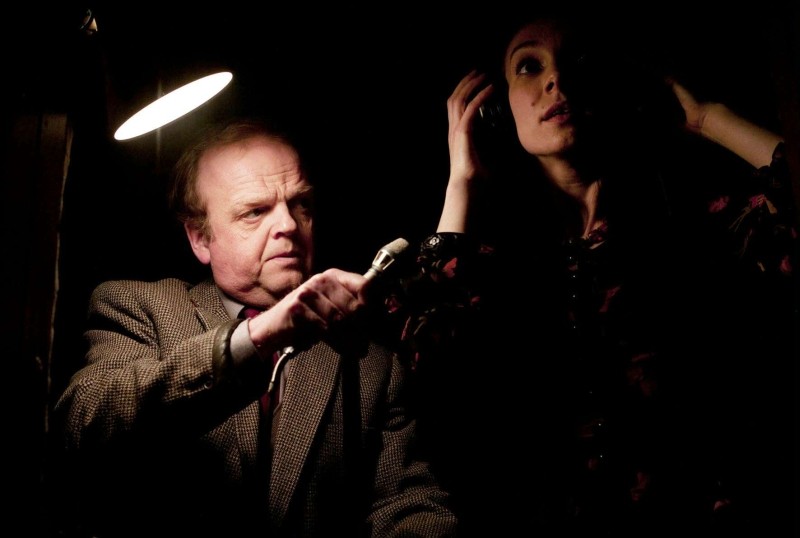8. Let the Right One In (2008)
Love is in the cold winter air of Stockholm, when two lonely child neighbors build a friendship and romance in a short period of time. One of them is Oskar, a boy who lives with his mother, and only occasionally sees his father. He is also a social outcast at his school, constantly being subjected to bullying, which leads him to developing repressed violent tendencies.
The other child is Eli, who moved in next door to Oskar, with her much older guardian, Hakan, who prowls the night for unsuspecting victims to drain their blood and bring it back to feed Eli. Eli is a vampire, which warrants isolation and secrecy from the rest of society.
This is less a horror story, and more a coming-of-age tale where the kids learn of the different aspects of one another, and the closer they get, the more complete they appear to be. Eli encourages Oskar to become much tougher during his confrontations with his tormentors. Eli, is almost incapable of going through a change of lifestyle and personality, as the curse of the vampirism is too strong, and there is a constant battle to wrestle that aspect away from Oskar’s presence in order to protect him.
Whereas Eli sees it as a curse, Oskar finds it to be a fascinating aspect of his new friend’s life, and only judges Eli based on the principles he was taught by his parents and teachers. The issues of acceptance and alienation are handled with much affection and care, without disrupting the beautifully flowing narrative.
With strong direction from Tomas Alfredson, stunning cinematography from Hoyte Van Hoytema, a moving score from Johan Soderqvist, and great performances from the primary actors, Let the Right One In sheds new light on the vampire mythos (No pun intended), and proves that horror storytelling has always had a warm heart beneath the flesh.
9. Coraline (2009)
Neil Gaiman, author of American Gods and the Sandman comics, has always felt that in fantasy and horror literature, children should never have to read about their cyphers constantly cowering in fear and learning nothing from their dangerous encounters but rather be afforded the opportunity to discover the courage within, either on their own terms or aided by the wisdom of a watchful guardian.
Coraline, sees the titular character, a young girl undergo such a transformation. She moves into a new town with her parents, both of whom are interested in things that bore her and make her more restless. After getting to know the colourful oddities that populate the neighborhood, Coraline discovers a hidden portal in her new home that allows her to travel to another dimension.
This new world features alternate versions of the people she met, and it all seems to rest under the power of her “other mother”; a woman who is exactly the same as her real mother, save for the fact that she has buttons for eyes. In fact, every resident in this new world, has buttons sewed into where their eyes should be, but even Coraline is willing to overlook this anomaly, as she is quite taken aback by the bountiful states of comfort, excitement and luxury.
The “Other Mother” promises Coraline that she will be taken care of forever, if she promises to make one modification… which is to sow buttons onto where her eyes should be. While that notion alone is scary enough, the terror is heightened once the threat follows Coraline back into her real world.
The movie is a labor of love, directed with affection and precision by Henry Selick and his passionate team of artists who breathe life into the art of stop motion animation. Coraline herself is a flawed but strong character, and learns to endure hardships in order to take responsibility for those that matter to her the most.
The dark fantasy parable is great entertainment for the eyes and the minds of adults and children alike, and may even make one appreciate the lives they already lead, no matter how dull or uninspiring it might look on the surface.
10. The Cabin in the Woods (2012)
A group of teenagers of identifiable characteristics, head to an isolated cabin for a fun weekend, are completely unprepared for an unknown terror already waiting for them. The Cabin in the Woods takes this overused synopsis in American horror cinema, and gives it a unique twist; what if the teenagers were manipulated to come to this cabin for the greater good of mankind’s survival?
Director Drew Godard wrote the script with the visionary Joss Whedon, and the film is as subversive as it sets out to be, from the opening scene until the very end. They simultaneously invigorate the genre with new ideas and a fresh perspective, while giving cinemagoers and horror fans the “last” horror story. There is also a fine balance of honoring classic horror films while satirizing the lazy, and often, simple-minded tropes that tend to accompany them.
The Cabin in the Woods gives more depth to the shallow teenagers, ridiculous storylines and preposterous creations of 20th century “slasher film” cinema. In the ashes of the old mythology, spawns a new one, and by the end, it is unleashed upon the masses.
11. Red State (2011)
There is a scene at the Five Points Trinity Church where Pastor Abin Cooper (played by a charismatic Michael Parks) gives a sermon to his whole family, about the sins of man in the United States, where his hatred for homosexuals and pre-martial sex is placed side by side with his hatred for pedophiles.
All of this happens, while a teenager, captured after being tricked into pursuing easy sex, is locked in a cage while his two friends are bound elsewhere in the room. This scene represents the best of Kevin Smith’s cinematic achievements, as it combines his love of words with heightened tension (something that may not have been very apparent in his works prior to this).
Primarily known for having geeks discuss comic books, hockey, masturbation and Star Wars, Smith puts the members belonging to the real life Westboro Baptist Church under the microscope in this darkly humorous satire of religious extremism. The terrorists are relentless in their crusade to purge the United States of those they believed go against god, and make their land unfit for their never-ending supply of children to be raised in.
The movie is best seen as two different pieces; The first one being a very claustrophobic piece of religious intolerance, and the other taking the form of a siege by a federal law enforcement task force.
In addition to criticizing the monstrous nature of the pastor and his sheep, Smith also questions the authority and ethics of the American government in a post 9/11 state of mind. Whatever ones politics may happen to be, Red State is sure to scare young boys into thinking twice before going out of their way for cheap sex.
12. You’re Next (2011)
You’re Next is set around a family reunion being held at a vacation home in the woods. The protagonists, Crispian, a teacher, and his girlfriend, Erin (also his former student), are deliberately portrayed as the most interesting characters in contrast to Crispian’s immediate family and their significant others.
They include the typical older brother who bullies Crispian about how dorky he was (or is), the successful father who condescends to his son about his seemingly pathetic career situation and the mother who puts on a cold front towards her son’s lower-class girlfriend.
With other archetypal oddities and annoyances populating the soiree, uninvited guests wearing various animal masks (which may or may not be symbolic) surround and invade the house, murdering their victims with crossbows and elaborate deathtraps.
There is a subtle metatextuality that is apparent over the course of Adam Wingard’s darkly comic thriller. Much like The Cabin in the Woods, the film has an obvious love and appreciation for the “slasher” and “survival horror” films of the 1980s, while also being able to criticize their flaws and shortcomings.
You’re Next plays with the ridiculous caricatures that have been standard for formulaic “slasher” films from the 1980s, and has an unapologetic sense of excitement and fun when indulging in the most brutal violence directed at either the “innocents” or the “monsters”. It contextualizes the one or two-dimensional nature of some of the supporting characters by satirizing the shallowness and snobbery of the elite, upper class whose corporate endeavors might have cost them their humanity.
And yet, when nasty things happen to certain people, there is a good balance of comic relief and a genuine sense of horror, which perfectly captures the absurd and mindless nature of the violence portrayed within the genre’s history.
The film also, rather wittily, explores the significance of the action heroine and deconstructs gender roles and stereotypes in American horror cinema. Whether one sees it for a good laugh or a good shock to the system, Adam Wingard and (screenwriter) Simon Barrett’s love letter to “slasher” cinema is set to subvert one’s expectations and deliver on both its promises.
13. Kill List (2011)
Jay and Gal (played by Neil Maskell and Michael Smiley, respectively) became contract killers after leaving the military. Jay, a married man, is emotionally unstable and the more impulsive of the duo, while Gal is a bit more collected and practical, despite coming off as a shady persona.
Through the encouragement of Gal, Jay is encouraged to pursue an assignment to support his wife and son. After the two men reach the hotel where the meeting will take place, Jay asks Gal if the weapons they are carrying might be too extreme for the appointment. Gal reminds him that they do not know their mysterious client. As they depart the car, a rainbow is seen in the background, while a low-key but ominous music score enhances the mood as the men walk to the hotel.
The ambiguous composition of the aforementioned scene cleverly captures the essence of Kill List, by throwing both its audience and its protagonists into a labyrinth of uncertainty. On one hand, both Jay & Gal are desensitized to the idea of killing, but on a grander cosmic scale, the murderous nature of their job can be overlooked. As the level of danger rises, and the darker the mystery becomes, the characters become increasingly empathetic.
Ben Wheatley expertly crafts a unique vision, putting together a film that seamless blends crime, drama and horror with the experimental sub-genres that populated cinemas in the 1970s and 1980s, such as The Wicker Man (1973) and Race with the Devil (1975). The film never caters to its audience with easy answers to the madness that travels throughout, and continues to leave viewers in a state of disbelief, even after the end credits begin to roll.
14. Sightseers (2012)
Dr. Mark Kermode, (a noble knight of cinema, and a fan of Ben Wheatley’s works) writes on Sightseers: “The result is a sick and twisted affair; very funny, very nasty and very British.”
Co-writers Alice Lowe and Steve Oram play two psychotic lovers who go away on a road trip for inspiration and erotic adventures. During their visit to various landmarks and locales, the couple begins to see different sides of each other’s personality the tension continues to increase, whether they are left to their own thoughts or hang out together. They both fulfill their creative needs and suppress their apparent disgust with one another by being extremely vigilant and murdering those they deem to be indecent.
A Ben Wheatley film will always apply a different type of experimentation to the narrative. With the great A Field in England, his characters were psychologically tormented by an unseen force and the psychedelic atmosphere invoked the free spirited surrealism of acid westerns like Alejandro Jodorowsky’s El Topo and Jim Jarmusch’s Dead Man.
With Sightseers, the titular duo captures the essence of the protagonists in both Henry: Portrait of a Serial Killer and Natural Born Killers. Lowe and Oram share an adorable, believable chemistry that they would not strike an unsuspecting traveller as desensitized killers. That notion solidifies the fear already brought on by the various mind games played throughout the film, and the twisted sense of logic that the characters use to justify their actions.
15. Berberian Sound Studio (2012)
Gilderoy (played by the great Toby Jones), is a sound engineer hired to work on a film titled, “The Equestrian Vortex”, and is horrified to find out how misogynistic and violent the nature of the project actually is (Welcome to the world of Giallo, Gilderoy).
The cast and crew of the production are not as hospitable as one would hope to their foreign guest, and there is a mysterious aura of conspiracy and threat creeping throughout the film. Toby Jones, marvelously plays Gilderoy as a kindhearted but timid creature, and brings pathos to the character within the visceral freak show.
Without sounding like a gimmick, the use of audio is a very important aspect of Berberian Sound Studio; the more accustomed the audience becomes to the ambience (no matter how terrifying), the more unnerving things seem to be when sound is no longer audible.
Berberian Sound Studio rather ingeniously avoids showing any footage from “The Equestrian Vortex” and allows the audience to imagine how traumatizing the film’s content might be based on Gilderoy’s facial expressions and reactions, and of course, from the various sounds gradually incorporated in the post-production process. The screams of the actresses, the smashing of fruit and Gilderoy’s effective design heighten the already tense and hostile atmosphere of the film.
There is a passionate love for filmmaking that is evident in the film; from the dusty, grainy cinematography and the meticulous production design to the haunting, ominous music that is heard from the beginning to the very end. The film manages to dissect the Giallo genre for both casual novices and long time lovers, without catering to either party.
The film touches on the true horrors that people may experience more often than not, which is all the scary happenings in one’s mind; the paranoia, the repressive tendencies, the uncertainty and everything that is not tangible, elevates the intensity of the Giallo genre, more so than if it were played out as a visual orgy of sex and violence.
